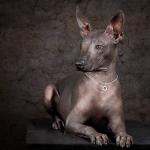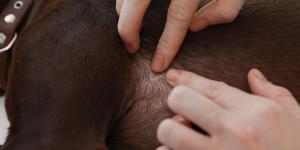Mexican Hairless Dog (Xoloitzcuintle)

The Xoloitzcuinti dog, also known as the Mexican hairless dog or Xolo, is originally from Mexico. In Mexico, the Xolo is highly valued and even considered somewhat of a living archaeological jewel, since this dog breed was a companion of the Aztecs more than 7,000 years ago. This dog is also known worldwide because of its incredibly unique appearance.
For more about the required care and training of the Xoloitzuintle, as well as its physical and personal characteristics, keep reading here at AnimalWised.
- America
- Mexico
- Group V
- 5-14
- 14-18
- 18-22
- 22-27
- 27-31
- More than 31
- 2-7
- 7-22
- 22-55
- 55-100
- 100-220
- 8-10
- 10-12
- 12-14
- 15-20
- Low
- Meidum
- High
Origin
The Mexican hairless dog’s origins date back to the Aztecs. Today there are several archaeological findings, such as figurines made with terracotta or pictorial representations, which honor the Xolo.
This dog breed was venerated by the Aztecs, since they considered it a living representation of their god Xolotl, the Aztec god of death. Despite being the god of death, Xolotl was not evil, he was simple in charge of the underworld.The Aztecs believed that Xolo dogs were created by their god, who made them with a splinter from the bone of life to help guide the deceased in their journey to the hereafter. This is why when they died, a Xolo would be sacrificed and buried together with the deceased. In addition, many considered that contact with the Mexican hairless dog alleviated pain, and that the consumption of their meat had various benefits both ritually and nutritional.
After America was colonized, the Xolo breed suffered a noticeable decline, almost reaching extinction. In the nineteenth century, thanks to various breeders who sought to preserve this dog breed, the FCI decided that they should take measures and save the breed.
For more, we recommend reading our article where we discuss the top 15 rare dog breeds.
Physical characteristics
Xolos are classified into three subtypes according to their height and size:
- The standard variety: which weighs between 11 and 18 kilograms and measures 51 to 76 centimeters in height.
- The mediam:7 or 14 kilos and 38-51 cm.
- Finally, miniature: which would range of between 2 and 7 kilos and 23-26 cm.
A Xolo’s body is compact and muscular with a thin head, straight snout and no hair (or little hair). Their eyes are almond and usually brown, but dark is more appreciate. Its ears are erect and triangular in shape.
Some Xolos have hair, while others have close no hair at all. If they do have hair it will be short and dense, and appear more abundant in the head and tail. In terms of colors, there is a wide range of shades that may appear, such as brown, black, gray, bronze, blond, reddish or stained, but, in general, they are usually solid and rather dark colors.
Character & temperament
If we look at both the character and temperament of the xolo, we must emphasize that it is an ideal dog for families. Xolo’s are obedient, intelligent, loyal and very friendly dogs. In addition, because they are both alert and attentive, they are considered great guard dogs. Xolo’s are patient and playful, therefore, they are great dogs to play children.
In general, xoloitzcuintle dogs are affectionate animals, who love to offer attention and dedicate time and love to their families. Xolos do, however, require time, attention and enough walks, as they are prone to separation anxiety if left alone for too long.
Xoclos are incredibly intelligent and attentive and are easy to train.
Care
Due to the absence of hair, xoloitzcuintles are more easily exposed to injuries, burns, allergies or chafing on their skin. This means that one would need to pay attention to factors such as sunlight and allergens, for this reason, you would need to apply protective creams to prevent burns.
Because their skin is so exposed, it is necessary to bathe this dog regularly. If they are not cleaned, they can suffer from clogged pores which often leads to pimples. If these pimples appear and are not treated in time, this could lead to an infection. When bathing a Xolo, you will need to use specific products for sensitive skin, as well as a suitable sponge to not irritate the skin. Once bathed, it is advisable to apply moisturizing products on the Xolo’s skin. And for the care of a xoloitzcuintle with hair, it will be necessary brush and remove dead hair 2-3 times a week.
Xolo’s are a hypoallergenic dog breed, making them the perfect dog for people with allergies. Apart from these special considerations for the breed, preventive measures for all dogs needs to be taken, such as internal and external deworming, vaccinations, balanced feeding, exercise, oral and eye hygiene and regular visits to the veterinarian.
Education
As we have already mentioned, educating a Xolo is easy! All you will need to do is follow some basic guidelines with consistency to achieve results. It is, however, recommended that you begin training your Xolo from when it is young, especially in terms of socialization. If your Mexican hairless dog is not well educated or socialized, it can be sullen and distrustful with strangers.
We recommend avoiding collars which can be damaging to your Xolo’s skin, opt rather for nylon collars or natural fibers that do not irritate the skin. In addition, we always recommend using positive reinforcement.
Health
Despite being a healthy breed in general, Xolo’s can, like other races with similar characteristics, present some conditions such as hip dysplasia. If you notice anything out of the ordinary with your Mexican hairless dog, we recommend consulting a veterinarian as soon as possible. These dogs may also present other joint problems such as patella dislocation.
Xoloitzcuintle are also prone to suffering from oral and dental problems, such as the fall or absence of teeth, as well as jaw malformations. For this reason, these dogs require extra oral care and should avoid eating bones and hard foods.
These dogs also have a tendency of suffering from liver disorders, specifically those associated with the absence of fur, ie skin disorders such as dermatitis and allergies.
- Xoloitzcuintle. Fédération Cynologique Internationale.
- Xoloitzcuintle. Federación Canófila Mexicana A. C.
Mexican Hairless Dog (Xoloitzcuintle) photos










